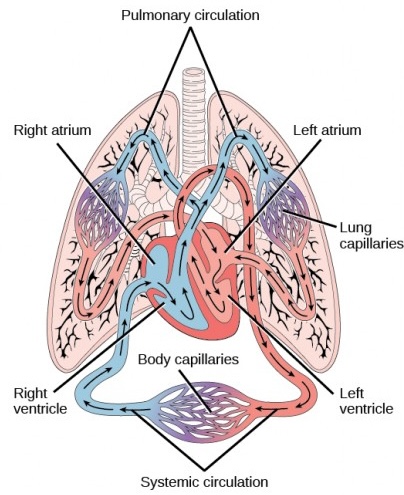A single bout of aerobic exercise places a significant metabolic demand on the body, especially the cardiovascular, respiratory, and muscular systems. Repeated exposure to the acute stress of exercise, combined with chronic exercise training, results in functional and morphological adaptations in all body systems. Understanding the acute effects of aerobic exercise provides a foundation for recognizing chronic adaptations.
The primary function of the cardiovascular system during aerobic exercise is to deliver oxygen and nutrients to working muscles while removing metabolic waste. The following sections discuss key cardiovascular mechanisms during acute exercise.
Cardiac output ( is the total amount of blood pumped by the heart per minute. It is determined by stroke volume (the amount of blood ejected per beat) and heart rate (the number of beats per minute).
Initially, cardiac output rises rapidly before gradually reaching a plateau. At maximal exercise, cardiac output can increase from a resting level of approximately L/min to as high as L/min in trained individuals.
Two primary physiological mechanisms regulate stroke volume:
During aerobic exercise, an increased venous return (due to venoconstriction and muscle pump activity) enhances end-diastolic volume, leading to greater cardiac emptying (Frank-Starling mechanism). This increases stroke volume, though it plateaus at approximately 40-50% of maximal oxygen uptake.
As exercise begins, heart rate increases due to sympathetic nervous system activation. The rate of increase is proportional to exercise intensity.
Oxygen uptake () is the amount of oxygen consumed by tissues. It depends on:
Maximal oxygen uptake (max mL/kg/min) is the highest amount of oxygen an individual can utilize during exercise and is a key indicator of cardiorespiratory fitness.
The a- difference refers to the difference in oxygen content between arterial blood and venous blood. It represents how much oxygen is extracted by the muscles from the blood and is an important factor in determining .
Another measure of oxygen uptake is metabolic equivalent (MET), which represents the energy cost of physical activity. One MET is defined as the resting metabolic rate, or approximately mL per kg body weight per minute. Exercise intensity is often expressed in METs, with higher MET values indicating greater oxygen consumption.
Systolic blood pressure increases significantly during aerobic exercise due to greater cardiac output, whereas diastolic blood pressure remains relatively stable or slightly decreases due to vasodilation.
Mean arterial pressure (MAP) represents the average blood pressure during the cardiac cycle:
During aerobic exercise, vasodilation occurs in active muscle to increase blood flow, while vasoconstriction in less active areas helps regulate overall circulation. Up to 90% of cardiac output can be directed to working muscles.
Aerobic exercise significantly impacts the respiratory system, increasing both tidal volume (air per breath) and breathing frequency.
Gas exchange is driven by partial pressure differences between alveolar air, arterial blood, and tissues. Oxygen diffuses from the blood into working muscles, while carbon dioxide moves from the muscles into alveolar air for expiration.

Oxygen is transported in the blood either dissolved in plasma or bound to hemoglobin. Since oxygen is not highly soluble in plasma, only about 3% of it is carried in this form. The majority of oxygen transport relies on hemoglobin, which carries approximately 1.34 mL of oxygen per gram of hemoglobin.
Carbon dioxide transport follows a similar mechanism, with a small percentage dissolved in plasma and the rest carried as bicarbonate ions (HCO₃⁻) or bound to hemoglobin. Bicarbonate formation is essential in maintaining blood pH during exercise.
Lactate, another metabolic by-product, accumulates during high-intensity exercise. When lactate production surpasses removal, it leads to an increase in blood lactate concentration, marking the onset of blood lactate accumulation (OBLA).
Sign up for free to take 5 quiz questions on this topic